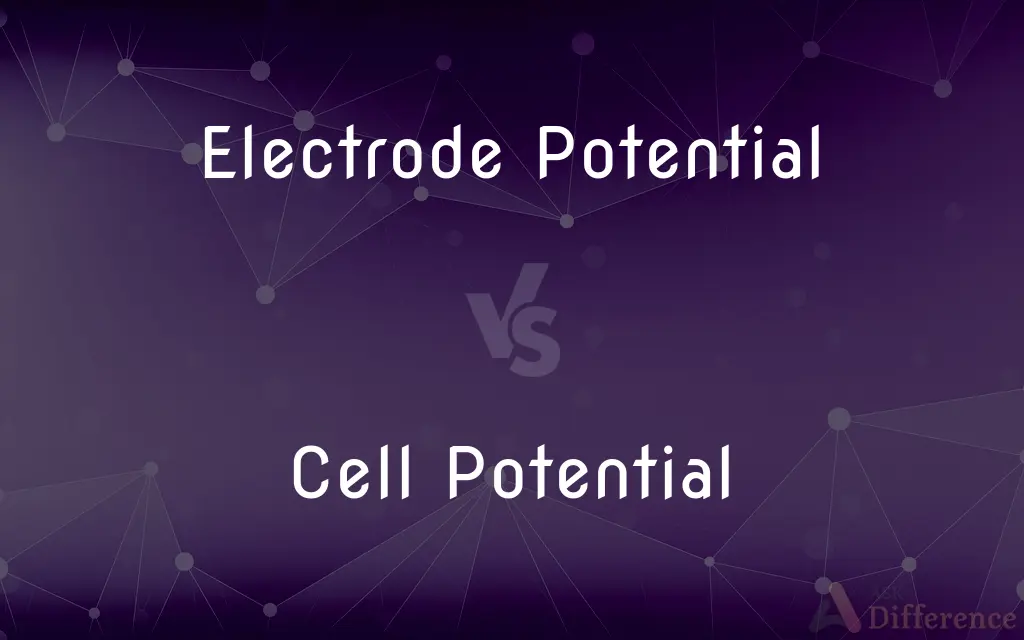Electrode Potential vs. Cell Potential — What's the Difference?
By Tayyaba Rehman — Published on January 18, 2024
Electrode potential is the voltage developed at a single electrode in an electrochemical cell relative to a standard reference electrode, while cell potential, also known as electromotive force (EMF), is total voltage output of an electrochemical cell.

Difference Between Electrode Potential and Cell Potential
Table of Contents
ADVERTISEMENT
Key Differences
Electrode potential measures the tendency of an electrode to lose or gain electrons when it is in contact with its ion in solution. Cell potential is the difference in electrode potentials between two electrodes in an electrochemical cell and represents the cell's ability to produce an electric current.
Electrode potential is a half-cell potential and is always measured under standard conditions against a standard hydrogen electrode. Cell potential, on the other hand, is calculated by combining the potentials of two half-cells, indicating the overall driving force of the electrochemical reaction.
The electrode potential is specific to the type of electrode and its environment and does not provide information about the cell's total potential. Cell potential provides a complete picture of the cell's electrochemical driving force and is essential for predicting the direction of the redox reaction.
Electrode potentials can be either positive or negative, depending on the electrode's tendency to act as an anode or cathode. The cell potential is the sum of the anode and cathode potentials and is used to determine the feasibility and direction of the electrochemical reaction in the cell.
In practical applications, electrode potential helps in understanding the behavior of individual electrodes, while cell potential is crucial for the design and analysis of the entire electrochemical cell, such as in batteries or electrolysis processes.
ADVERTISEMENT
Comparison Chart
Definition
Voltage at a single electrode relative to a standard reference.
Total voltage output of an electrochemical cell.
Measurement
Measured under standard conditions against a standard hydrogen electrode.
Calculated by combining potentials of two half-cells.
Information Provided
Indicates the tendency of an electrode to lose or gain electrons.
Indicates the overall driving force of the cell's electrochemical reaction.
Application
Specific to individual electrode behavior.
Essential for the overall design and analysis of the cell.
Significance
Helps in understanding half-reactions.
Determines cell feasibility and reaction direction.
Compare with Definitions
Electrode Potential
Electrode potential indicates whether an electrode will act as an anode or cathode.
Based on its positive electrode potential, silver acts as a cathode in the cell.
Cell Potential
Cell potential is used in designing batteries and electrolytic cells.
The cell potential was a key factor in designing the new type of battery.
Electrode Potential
Varies with the concentration of ions around the electrode and temperature.
The electrode potential of the half-cell changed with the alteration in ion concentration.
Cell Potential
It represents the sum of the potentials of the anode and cathode in a cell.
The cell potential was calculated by adding the electrode potentials of both half-cells.
Electrode Potential
Electrode potential is the measure of the ability of an electrode to gain or lose electrons.
The electrode potential of copper was measured to understand its oxidizing power.
Cell Potential
Cell potential is the overall voltage produced by an electrochemical cell.
The cell potential of the battery was measured to determine its power output.
Electrode Potential
It is a half-cell potential relative to a standard reference electrode.
The electrode potential of zinc was found to be negative compared to the standard hydrogen electrode.
Cell Potential
Cell potential determines the feasibility of a redox reaction in a cell.
A positive cell potential indicated that the reaction in the electrochemical cell was spontaneous.
Electrode Potential
Electrode potential is crucial for predicting the direction of half-reactions.
The electrode potential helped determine the direction of reduction at the electrode.
Cell Potential
Also known as electromotive force (EMF) of the cell.
The EMF of the galvanic cell was determined to be 1.1 volts.
Common Curiosities
Does electrode potential change with concentration?
Yes, it can change with the ion concentration around the electrode.
What does a positive electrode potential indicate?
It indicates a tendency of the electrode to gain electrons (reduce).
Is cell potential always the sum of two electrode potentials?
Yes, in a typical electrochemical cell.
Can cell potential be negative?
Yes, a negative cell potential indicates a non-spontaneous electrochemical reaction.
How is cell potential used in electrolysis?
It helps determine the minimum voltage needed for the electrolysis process.
Does cell potential affect the lifespan of a battery?
Indirectly, as it relates to the overall efficiency and capacity of the battery.
What is the standard reference electrode used in measuring electrode potential?
The standard hydrogen electrode (SHE) is commonly used.
How is cell potential related to battery efficiency?
Higher cell potential generally indicates a more efficient battery.
Can two identical electrodes have different electrode potentials?
Yes, if they are in different chemical environments.
What role does temperature play in electrode potential?
Temperature changes can affect the electrode potential.
Is a higher electrode potential always better?
It depends on the specific application and desired chemical reaction.
Can electrode potentials be used to calculate cell potential in any redox reaction?
Yes, as long as the redox reaction occurs in an electrochemical cell setup.
Is electrode potential a constant value?
No, it varies depending on environmental conditions.
Can electrode potential predict product formation in electrolysis?
Yes, it helps predict which ions will be reduced or oxidized.
What determines the direction of current flow in a cell?
The direction of current flow is determined by the cell potential.
Share Your Discovery

Previous Comparison
Gross Method of Cash Discount vs. Net Method of Cash Discount
Next Comparison
Gel Electrophoresis vs. SDS-PAGEAuthor Spotlight
Written by
Tayyaba RehmanTayyaba Rehman is a distinguished writer, currently serving as a primary contributor to askdifference.com. As a researcher in semantics and etymology, Tayyaba's passion for the complexity of languages and their distinctions has found a perfect home on the platform. Tayyaba delves into the intricacies of language, distinguishing between commonly confused words and phrases, thereby providing clarity for readers worldwide.













































